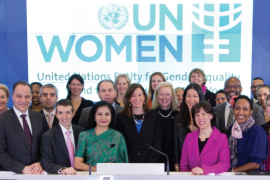I remember sitting in the dimly lit recovery ward of the hospital, clutching my friend’s hand. She had given birth just hours earlier, but something was “off”; her heartbeat fluttered, she was dizzy, pale. The midwife seemed overworked, rushing through checks; the doctor delayed. By morning, my friend was slipping into hemorrhagic shock, having lost too much blood. Against the odds, she survived, but only because one nurse, refusing to look away, insisted the drip be replaced and a specialist called. That moment toggled between life and death, and it showed me how fragile “safe care” really is, especially for women.
That story isn’t unique. All around the world, women face uneven odds in hospitals and clinics, simply because systems designed to protect all still leave too many exposed. On World Patient Safety Day 2025, we shine a light on those gaps, celebrate those who fight as’ guardians of patient safety’, and call for concrete action.
The Landscape: Where We Stand
According to the World Health Organization, about 260,000 women died during and following pregnancy and childbirth in 2023. Nearly 92% of those deaths occurred in low- and lower-middle income countries.
Globally, between 2000 and 2023, the maternal mortality ratio (MMR) dropped by about 40%, a huge achievement, yet the rate remains alarmingly high, especially in regions like Sub-Saharan Africa, which alone accounted for roughly 182,000 of these deaths in 2023.
In the United States, while maternal mortality has shown some recent improvements, terrible disparities persist. The maternal mortality rate fell from 22.3 deaths per 100,000 live births in 2022 to 18.6 in 2023. But Black women still suffer disproportionately: their maternal mortality rate remains around 50.3 per 100,000 live births, far higher than rates for White, Hispanic, and Asian women.
Meanwhile, globally, reduction rates are slowing. Aid cuts, resource constraints, conflicts, and fragile health systems threaten to reverse hard-won gains. The WHO warns that funding gaps, especially in maternal, newborn and child health, are risking “pandemic-like effects” on maternal deaths.
Challenges: What Stands in the Way
- Unequal Access to Qualified Care
Many women, especially in rural or conflict-affected areas, lack access to skilled birth attendants or safe facilities. Even when facilities exist, staffing, supplies, and follow‐up care are inconsistent. - Gender & Racial Bias in Healthcare
Women’s symptoms are more often dismissed or misattributed. Black women in many countries are more likely to receive delayed care, substandard treatment, or to experience adverse outcomes. In England, for instance, a 2025 report found that Black women are more than twice as likely to die in childbirth compared to white women. - Mental Health, Violence & Social Determinants
Mental health issues, violence (including domestic abuse), drug use, and broader societal inequalities play large roles. In the U.S., a recent study shows that homicide and suicide are among increasing causes of death for pregnant people. - Resource Constraints & Fragility
In low-income settings, fragile states, or during outbreaks or crises, health systems often collapse, making safe care harder to maintain. Aid cuts exacerbate shortages of medicines, personnel, training, and monitoring. - Data Gaps & Under-Reporting
Many deaths go unrecorded or misclassified; racial/ethnic or gender-based data is often poorly collected. This makes it hard to target reforms effectively.
Women Leading the Way: Voices and Heroes
- Becky Pomrenke, MSN, RN is the director of patient safety at USA Health. In 2025, she was named among “132 Patient Safety Experts to Know” by Becker’s Hospital Review. She oversees patient safety operations in multiple hospitals, cultivating safety culture, monitoring systems, and promoting staff training.
- Dr. Jill Kalman, MD, and Sandra Lindsay, DHSc, MSN, RN are leaders at Northwell Health (USA). During the COVID-19 crisis, they learned that safety depends heavily on moral courage, clear communication, and supporting every member of the care team. They are now building on those lessons to better protect patients, especially women, through systems that encourage speaking up about safety concerns, improving coordination and reducing harm.
- Mumtaz Patel, British nephrologist, was elected President of the Royal College of Physicians of London in 2025. She is the first woman of Indian origin to hold the role. Under her leadership, programs such as the Global Women Leaders Programme have been expanded. These aim to support female physicians, ensure quality of education, and promote leadership in healthcare systems.
- Many other women in health IT are also stepping up. A recent “100 Women in Health IT to Know 2025” list highlights how women are transforming patient safety through digital tools, data tracking, telehealth, and system redesigns.
Successes Worth Celebrating
- The global drop of ~40% in maternal mortality over 23 years (2000-2023) is a tremendous win.
- In the U.S., the reduction from 22.3 to 18.6 deaths per 100,000 live births within a year (2022-2023) shows what focused efforts, better policy, and public awareness can achieve.
- Some regions—Latin America & the Caribbean, are making strides via regional collaboration to push for “zero preventable maternal deaths.” But the progress is fragile; in some countries, mortality ratios are backsliding or stagnating.
- Strengthened leadership by women across global health, hospital systems, medicine, midwifery, and policy is raising the visibility of patient safety, setting up new training programs, implementing safety checklists, improving communication, promoting bias awareness, and advancing maternal health initiatives.
What Amazons Watch Magazine Urges
On this World Patient Safety Day 2025, Amazons Watch makes the following demands and recommendations, with a focus on women, equality, and real safety:
- Invest in Maternal & Reproductive Health Everywhere
Governments, international agencies, and donors must restore and increase funding to maternal, newborn, and child health. Essential services, safe delivery, emergency obstetric care, and trained midwives must be assured even in fragile or conflict settings. - Close the Equity Gaps
Policies must address racial, ethnic, and socioeconomic disparities. This includes mandatory data collection by race/gender, anti-bias training for health personnel, and community-led accountability mechanisms. - Strengthen Mental Health & Postpartum Support
Safe childbirth does not end at delivery. Postpartum depression, substance use, and domestic violence all need attention with resources, access, screening, and services tuned to women’s realities. - Empower Women as Leaders & Advocates
Support women in leadership within hospitals, health ministries, and global health agencies. Amplify the stories of women patient safety champions (like Becky Pomrenke, Mumtaz Patel, and others). Encourage mentorship, leadership training, and institutional change that centers women’s experiences. - Improve Data, Transparency & Reporting
Improve how we collect, classify, and share data: maternal deaths, near misses, adverse events with gender/race disaggregation. Use these data to drive policy and accountability. - Build Safety Culture in All Health Systems
Cultivate environments where staff can speak up without reprisal, where checklists and protocols are used, and where communication is open. Technologies and digital tools are important, but culture change is essential. - Engage Communities & Women Themselves
Women need information, agency, and a voice in their care. From health education to community health workers, women should be partners in developing and evaluating safe care.
Final Word
The woman in that hospital bed, my friend was saved not by chance, but by the alertness and courage of a nurse who refused to let her slip away. Stories like hers remind us that nurses and midwives are not only caregivers; they are protectors, advocates, and the bedrock of safe health systems.
Thank you for reading. If you believe in safer care for women everywhere, share this piece. Advocate. Vote. Mentor. Speak. Because change needs both hearts and hands.





Comments are closed.